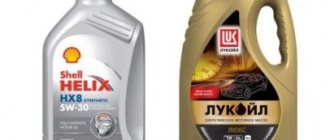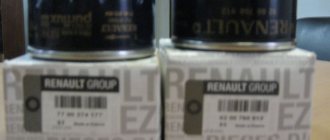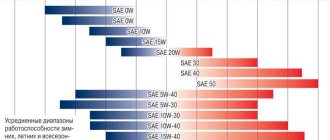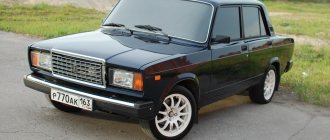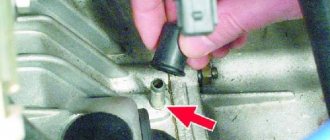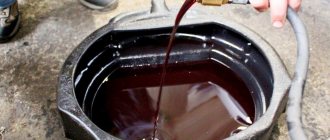Comparison of technical characteristics of Rosneft and Lukoil motor oils
A car owner who not only mercilessly exploits his vehicle, but strives to maintain it in proper technical condition, does not save money when purchasing consumables. However, even such a caring owner has to face difficult choices. In particular, when visiting a car dealership, the question arises which oil is better to choose: Lukoil or Rosneft. Finding the answer to such a question is quite difficult for a beginner, so we are ready to make the task easier, provide ready-made information, after reading which you will be able to figure out which oil product is best to buy to put into the engine of your own car.
Main characteristics of the oil
Any driver knows that oil is needed to lubricate the rubbing parts of the engine. However, each engine requires its own oil, which differs in viscosity, the presence of additional components, resistance to low temperatures and other parameters.
If the engine is filled with oil that is not suitable for some characteristics, then its operating mode is disrupted. When the oil does not match the viscosity, either its supply to the rubbing parts is impaired, or it quickly drains, which is why a too thin layer remains on the surface that cannot reliably protect the metal parts. When the oil does not match the composition of additives and additives, engine wear increases sharply in some modes . If the oil is not resistant enough to low temperatures, then in winter starting the engine turns into a lottery, winning which means that the engine has suffered minimal damage. After all, frozen oil is very thick, so the pump cannot supply it to the rubbing parts of the engine in sufficient volume, which is why friction occurs “dry”, without lubrication.
In addition to viscosity, which is determined according to the American method and designated by the term SAE, there is also the API index, which describes the purpose of the oil by engine type. Often, when choosing oil only according to SAE, the driver or car owner does not take into account the API parameter, which is why a seemingly suitable oil worsens engine performance, increases fuel wear and leads to other unpleasant consequences. For example, pouring oil of API classes SH to SM into an engine manufactured in the late 70s or mid-80s will lead to constant leaks and a rapid decrease in the service life of both the engine and the oil. And pouring oil of API classes from SE to SG into cars produced in the 2010s will lead to the rapid appearance of scuffing on the crankshaft liners and cylinder walls. Moreover, any oil will produce this effect, not only Lukoil, but also the most popular and high-quality branded oil.
Features of domestic oils
Those who believe that only foreign auto chemical products meet international requirements are seriously mistaken, since domestic oil may turn out to be even better in some technical and operational parameters. In addition, the domestic product not only has good parameters, but its price is also more attractive than that of an expensive foreign analogue. Also, domestic oil is successfully combined with fuel, which is sold at gas stations. Naturally, the composition and quality of domestic fuel differ significantly from that offered outside the home country.
As practice shows, low-quality domestic fuel can conflict with a good foreign engine oil product. Some car owners deliberately purchase low-quality fuel, not wanting to incur additional costs. Auto stores offer a wide range of domestic oil products aimed at car engines. Let's analyze the products of two popular manufacturers:
- Rosneft (also has another popular name - TNK);
- Lukoil.
Both of these manufacturers are very popular among domestic motorists.
Prices
When deciding which is better - Lukoil or Gazpromneft, you cannot ignore the cost of fuel. Here are the prices presented by operators for different brands of gasoline and diesel. Please note that the average information is given; the actual cost may differ slightly to a higher or lower cost.
| Company | AI-92 | 95 | 98 | 100 | Dt |
| Lukoil | 47,79 | 51,40 | 59,15 | 59,15 | 50,49 |
| Shell | 47,94 | 52,24 | 65,39 | — | 54,58 |
| E.K.A. | 47,53 | 51,53 | 63,78 | — | 51,06 |
| GazpromNeft | 47,05 | 51,40 | 61,50 | — | 50,17 |
| RosNeft | 47,05 | 51,95 | 63,20 | — | 49,99 |
| Neftmagistral | 46,24 | 50,84 | 61,79 | — | 50,27 |
| Route | 47,54 | 50,54 | — | — | 50,27 |
| TatNeft | 47,94 | 50,34 | 62,69 | — | 48,86 |
| TNK | 45,95 | 51,05 | 63,10 | — | 49,97 |
For the purity of the experiment, we took data for Moscow and the region; the price in the regions may differ from the information presented. We can conclude that it offers a lower cost. However, you can only decide which gas station is best by knowing which fuel is better.
Motor gasoline market:
Comparison by main characteristics
Realizing that both Lukoil and Rosneft are successful manufacturers offering quality products, you still have to make a comparison to understand which oil to buy. Let's consider how motor oil copes with loads under different operating modes of the vehicle.
Starting in the cold
If nature decides to present an unexpected surprise, accompanied by a sharp drop in temperature, car owners get a chance to check the quality of their motor oil. In severe frosts, starting the engine of your favorite car turns out to be quite difficult. You've probably seen how avid motorists have to abandon their cars and take public transport to get to work. This is exactly the case when low temperatures did not allow the engine to start.
Rosneft oil fluid demonstrates good starting characteristics. At the same time, experts draw attention to the fact that even with a strong decrease in temperature, the viscosity of Rosneft oil remains quite high. However, it should be noted that Rosneft MM contains a large amount of sulfur, which causes serious contamination of the engine. But Lukoil provides engine oil fluid with low sulfur content, and this product has a better viscosity index.
Power and consumption
It is also useful to pay attention to the characteristics that affect engine power performance. In this matter, Lukoil also takes a leading position, ahead of Rosneft. We also draw your attention to the fact that Rosneft oil provokes greater fuel consumption during engine operation. For this reason, there are more and more people wanting to purchase Lukoil’s product.
Chemical composition
If you compare motor oils by chemical composition, it is useful to pay attention to the ash content. It is significantly lower for Rosneft, but the cleaning characteristics are much better for Lukoil. Lukoil also benefits from containing more zinc.
But Rosneft’s oil product is ahead of Lukoil in terms of indicators:
- critical load;
- welding loads;
- badass index.
By temperature
Engine oil will meet its specifications if the vehicle is operated under specified conditions. Motor fluid from Lukoil is capable of allowing the engine to function successfully at a maximum temperature drop of minus twenty-five degrees. But Rosneft oil can withstand even thirty-degree frost. If we compare the focus on maximum temperature, then Lukoil wins, the product is able to withstand 40-degree heat, while Rosneft maintains its characteristics up to the maximum maximum - 35 degrees.
Price
If you pay attention to the price indicator, then the Rosneft product is suitable for those car owners who want to save on everything. Rosneft motor oils are cheaper than Lukoil products, however, it should be noted that the difference is not very significant.
Popularity comparison
Comparing Lukoil and Rosneft motor oils in terms of popularity, it is easy to understand that Lukoil’s product is sold out faster, since most car owners prefer to purchase this particular motor fluid, which is ideal for any domestic car. Although we will not deny that some motorists actively purchase only Rosneft oils and remain absolutely satisfied with their performance characteristics.
So, we hope that, having familiarized yourself with the main distinguishing features of these two manufacturers, you will be able to choose for yourself the best option for engine oil that will ensure the successful functioning of your car.
First place
Lukoil
The company produces motor oils for almost all categories of cars. A separate series of motor oils from the specified manufacturer has more than 50 items. The company’s advantage is the development and production of mixtures for various types of power units operating under different operating conditions.
Synthetic products under the Lukoil brand have the following advantages:
- protects the motor from wear in harsh operating conditions;
- provides noise reduction;
- promotes fuel economy;
- prevents the formation of high-temperature deposits;
- has good cleaning properties;
- the liquid does not change its structure at high and low temperatures;
- affordable price: it costs 2 times cheaper than foreign analogues, but is not inferior to them in quality;
- replacement period up to 10 thousand km.
There are no obvious shortcomings.
The quality of Russian motor oils – myth or reality?
Have you ever wondered why Russia has such a truly Russian attitude towards everything Russian? That is, AvtoVAZ is firewood, UAZ is scrap metal, GAZ is a minibus, and all patriotism ends faster than the word “patriot” sounds in the Luxembourgish language. These are three letters, if anything, but not what they write on the fence.
The collapse of the USSR and the first years of “young” Russia took their toll, and many cooperative bullies openly tarnished the reputation of all Russian production. Some still continue to cheat without fear of the punishing hand of justice and conscience, but we are not talking about them.
I asked for an opinion on which engine oil to choose for the domestic SUVs UAZ Patriot and UAZ Pickup. Moreover, he emphasized the word “domestic”, but no one had an associative series: for a Russian car - Russian oil. They suggested everything, even some exotic names, more like the name of a newly formed country somewhere in Africa.
Breaking stereotypes is a difficult and thankless job. Moreover, ten years ago I would have looked at myself today with a good dose of sarcasm: Russian oil? Don't make my horseshoes funny (c). But now I quite seriously want to evaluate the market for Russian-made oils. Great topic for research!
I drove to the nearest gas stations. Among domestic brands, oils from Gazprom, Rosneft, TNK and Lukoil are offered. Surely there is someone else, but their gas stations were not within my reach.
OLD STRATEGY FOR A NEW FIGHT
If they decided to draw parallels between the two examinations, then the test methodology must be completely identical. That’s what they did: the same three laboratories and three cycles of testing each oil sample. The first is a motor oil, in which each oil was first “rolled” according to a given program. The second is the determination of the most important physicochemical parameters. The third is tribological tests on a four-ball friction machine. And then the analysis of the results using the same rating scale that we used earlier.
How and from what are Gazpromneft and G-Energy oils made? Inspecting the Gazpromneft-SM plant in Omsk
There was an old enterprise in Omsk, rebuilt by the hands of captured Germans, for the production of motor oils of the M6G12 type. However, in 2009, the Omsk Lubricant Materials Plant (OZSM) became part of Gazpromneft - Lubricants, and more than 3.5 billion rubles were invested in imported equipment. I saw the French parent plant of the Mobil company - Gazprom’s is no worse! But.
X interwoven pipes with automatic valves, remote blending control center with large computer screens, robotic bottling and packaging lines. The Omsk complex, with a capacity of 300 thousand tons of oil per year, is as sparsely populated as the French one - less than 60 workers and operators manage everything. Except that the transshipment warehouse for nine thousand tons of products is not automated, and there are no robotic cargo trolleys scurrying between it and production.
Well, there are no distillation columns for oil distillation on the territory. Local, Russian, only mineral base for the simplest and most inexpensive oils (from 80 to 120 rubles per liter in four to five liter canisters): it comes directly through pipes from the nearby Omsk oil refinery, which also belongs to Gazpromneft. Unfortunately, our neighbor refinery cannot help with anything more technologically advanced. And while Lukoil or TNK companies produce their own hydrocracking base for their semi-synthetics, Gazpromneft-SM is currently forced to purchase it from the Korean company Zic. This, by the way, is not bad: VHVI base oils are made excellently in Ulsan. It’s also good that Gazprom’s finished semi-synthetics are much cheaper than imported pure Korean ones (145-240 versus 240-340 rubles per liter). But the “base”’s own production, which is carried out by Lukoil (from 120 rubles) or TNK (from 130 rubles), is even more profitable.
And only Tatneft makes polyalphaolefin bases (PAO) for top-end “synthetics” in Russia for its oils: Gazpromneft-SM buys PAO from Mobil. At the same time, Russian synthetic-based oil is one and a half times cheaper than Mobil 1.
Need I say that additive packages are only purchased? They are sold in finished form by Infineum, Afton, Lubrizol or Chevron Oronite. By the way, it was from Chevron Global Energy that in early 2009 Gazpromneft acquired a license to use oil production technologies along with a small (capacity of only 30 thousand tons per year) Chevron Italia SpA plant in Bari, Italy. They produce more high-tech lubricants under the G-Energy brand, while in Omsk they mainly produce oils of the more affordable Gazpromneft brand with a less complex additive package.
In the retail market, the share of Gazprom oils is small - only 5%: Lukoil and TNK, for example, have two to three times more. But Gazpromneft - Lubricants supplies lubricants to Russian conveyors of the Mercedes-Benz Trucks Vostok, Rostselmash, Derways, KAMAZ and Avtotor plants (for Hyundai vehicles). They could also compete for primary filling on the conveyors of foreign manufacturers - but they lose tenders because of the price: the lack of in-house production of the most popular hydrocracking base is hampered. Gazpromneft, in half with the Rosneft company, is going to launch its “hydrocracking” production in Yaroslavl only next year. And only then - in Omsk.
Fourth place
TNK
The company, which occupies a significant place in the oil market, is actively developing and produces several lines of transmission and motor oils. Magnum motor fluid, made using Ultratec technology, is very popular.
Product advantages:
- stability of the oil film in the most loaded engine components;
- protects the power unit from carbon deposits;
- ensures stable engine operation;
- reduces the amount of noise;
- has good anti-corrosion and cleaning properties;
- has good low temperature characteristics
The disadvantage is the high cost.
Motor oil Lukoil or Gazpromneft
- loading.
- loading.
Well, what can I say, I’ve already driven 7,000 km on oil and everything is fine with the engine, I didn’t see any difference in consumption, and the engine runs quietly and easily. The quality is very good, no problems observed!
Lukoil motor oil has performed well. (I drove 8 thousand kilometers on it).
Comments on the review
I replaced Castrol with Lukoil Genesys Armotech 5W30. I didn’t notice any difference, only in the economic part, which I’m glad about. Let's see in 8000 km how it behaves.
Excellent price-quality ratio, I change the oil every 6,000 km and under the valve cover it was as clean as ever, and there have never been any problems with the engine. I am satisfied and recommend it to everyone!
I am disappointed in this oil, as it burns very badly, at 2000 km 150-200 g, so it clearly does not live up to the declared characteristics, and I am not satisfied with this quality. If you have money, buy something more impressive!
Previously, they did a thorough overhaul of the engine, poured Lukoil Lux oil, changed 9-10 t/km, after a while they did a thorough overhaul again and everything was covered in resin. I agree to use our oils, etc., if they are made properly, they can do it well here, but alas, with us price comes first, and quality is far from good.
Normal Gazpromneft oil - I'm happy with it.
After switching from Mobile to Gazprom, I decided to make one test using the oil that I pour into my YaOpelek.
The test is as follows:
How oil protects the engine
Any oil reaches the parts rubbing against each other and forms a thin film on their surface with a minimum coefficient of adhesion. Film thickness depends on:
- oil viscosity;
- pressure in the oil system;
- condition of oil channels;
- air temperature;
- engine temperature;
- load on the engine.
The less viscous the oil, the greater the thickness of the protective film it forms, provided that there is enough pressure in the oil system. After all, the higher the viscosity (thickness of the oil), the more difficult it is to push it through the system. Moreover, each engine is designed for a certain film thickness, which provides maximum protection in certain modes.
The film thickness in idle mode is slightly greater than when operating under medium load and much greater than when operating under maximum load. This is due to the stress on the crankshaft and camshaft. When operating at idle speed, the load is minimal, therefore the pressure of the parts against each other is minimal, which means that there is quite a large space between the rubbing parts, which is filled by the film. In medium load mode, the crankshaft presses much harder against the liners, which reduces the distance between them. In maximum load mode, the shaft pressure on the liners is maximum, so the film thickness is minimal.
When the oil perfectly matches the engine, the lubricity of the film, regardless of thickness, is maximum. If the viscosity of the oil does not match the engine, then in some mode either the optimal film thickness changes or its lubricating qualities deteriorate. This equally depends on the other parameters that we have shown in the list. What happens when the thickness of the film or its lubricating properties do not correspond to the operating mode of the motor? Excessive viscosity increases resistance to crankshaft rotation.
Modern passenger car engines cannot boast of high torque, so high power is obtained by increasing the number of revolutions. Consequently, even a slight increase in the resistance to rotation of the crankshaft leads to an increase in fuel consumption and a decrease in engine power. If the oil viscosity is insufficient, the rubbing parts come into contact with each other, which leads to the appearance of scuffs on their surfaces. Each scuff, in turn, further worsens the operating conditions of the rubbing surfaces, which soon results in the formation of metal dust and shavings. When this happens, liner wear increases sharply, crankshaft vibration increases, and knocking noise occurs. After knocking occurs, the engine requires major overhaul.
The thickness and characteristics of the film also depend on the condition of the oil channels. During engine operation, burnt and unburned fuel particles enter the oil through the piston rings, which change the properties of the oil over time. In a working engine with the correct oil, this occurs after 6–10 thousand kilometers, depending on the driving mode. When this happens, soot from the oil begins to settle on the walls of the channels, reducing their throughput, which reduces the flow of oil and reduces the thickness of the protective film.
Air temperature is another important factor that affects the protection that oil provides to the engine. After all, the colder it is outside, the more the oil thickens, especially if it does not suit the climate. Synthetic and semi-synthetic oils change their characteristics less at low temperatures than mineral oils, but even such oils cannot protect the engine at too low temperatures. After all, their viscosity becomes too high, which is why they cannot create a film of the required thickness, and therefore their lubricity deteriorates.
Which motor oils are more popular - Lukoil or Gazpromneft?
In March 2021, on PartReview, Lukoil motor oils were generally more popular than Gazpromneft.
In terms of vote ratios, Lukoil motor oils surpassed Gazpromneft:
- For Lukoil, the ratio of positive votes (745) to negative (229) was 516 votes.
- For Gazpromneft, the ratio of positive votes (124) to negative (35) was 89 votes.
In terms of the number of reviews, Lukoil motor oils surpassed Gazpromneft:
- There are 313 reviews written for Lukoil motor oils: 231 positive, 22 neutral, 60 negative.
- There are 51 reviews written on Gazpromneft motor oils: 38 positive, 5 neutral, 8 negative.
Second place
Rosneft
Large company in the oil field. It has a fairly large range of products for cars, trucks, agricultural and shipbuilding equipment. Produces motor fluids that meet international standards.
The advantages of Rosneft motor oils include:
- good performance properties;
- products are adapted to domestic operating conditions;
- is a leader in the cold engine start category among Russian oils;
- reduces friction force in power units;
- has an extended replacement interval;
- affordable price;
- has good anti-wear characteristics.
The downside is that it has low energy-saving properties.
Watch the video to help you choose the best domestic motor oil.
Test of domestic semi-synthetic motor oils - rating of SL class oils - Za Rulem magazine
The preparatory stage did not inspire optimism: semi-synthetics better than the SL group are not yet produced in Russia. The number of participants is obviously modest. But the question, one might say, is political: can we or can’t we?
However, where there is politics, there is optimism: things are not so bad. If only because not all imported giants from the previous examination could boast of such an API class. And we are calling LUKOIL-Lux 10W-40 and TNK Magnum 10W-40 into the ring. 5W-40. In the “Start” category, this oil will be out of competition - “five” instead of “ten” according to SAE obviously gives it an advantage. But the “ten” from Rosneft exists only in the lower SJ class, so it’s not interesting to take it. And at the same time we will confirm (or refute) our old statement: the first SAE figure has practically no effect on anything other than cold start parameters.
The leader of previous tests, Shell Helix Plus 10W-40, was invited as a standard. This can also be called politics: if we lose, then at least we won’t be ashamed...
OLD STRATEGY FOR A NEW FIGHT
If they decided to draw parallels between the two examinations, then the test methodology must be completely identical. That’s what they did: the same three laboratories and three cycles of testing each oil sample. The first is a motor oil, in which each oil was first “rolled” according to a given program. The second is the determination of the most important physicochemical parameters. The third is tribological tests on a four-ball friction machine. And then the analysis of the results using the same rating scale that we used earlier.
The main conclusion was quite unexpected: our oils are much better than many people think. Let us remind you: we awarded the first prize for energy-saving properties. And here LUKOIL-Lux showed a result that was practically no different from Shell’s. The achievements of TNK Magnum and Rosneft Maximum are a little more modest, but quite at the level of most imported analogues and even better than some. By the way, the analysis of high-temperature viscosity gave the same conclusion as in the March examination: the viscosity-temperature characteristics of the LUKOIL product are close to optimal (which we observed in Shell, Zik and Esso oils). Hence the good efficiency of the motor, while the protection of friction units remains at the proper level. TNK and Rosneft oils have a slightly higher viscosity. This gives greater fuel consumption, but improves the resource-saving properties of these oils.
The second prize is for dynamics and power. The picture repeated itself: there is no clear leader, and differences in torque of 0.5–1.5% cannot be called serious.
Next is ecology. Here, the balance of motor indicators was taken into account, indicating an increase or decrease in the content of toxic components in the exhaust gases of a real engine and the content of substances potentially hazardous to nature - sulfur and phosphorus - in the oil. LUKOIL oil contains approximately the same amount of sulfur as the main sample of imported analogues; in the products of TNK and Rosneft there is a little more of it, but in this parameter they are practically no different from Shell.
AVERAGED MOTOR INDICATORS* *The results that are within the measurement error are highlighted in blue.
AVERAGED MOTOR INDICATORS* *The results that are within the measurement error are highlighted in blue.
The picture changed in the fourth stage. In the “Extreme Protection” category, our oils clearly outperformed Shell – this is clearly evidenced by the test results on a four-ball friction machine. The only fly in the ointment may be that even in the group of giants, Shell looked more modest than others in this category.
But what was most surprising were the results in the “Start” category. We remind you: here we were interested in the oil viscosity index, the conditional cranking temperature, low-temperature properties and the power of mechanical engine losses at low speeds. Among the imported oils, the leader was Shell with a viscosity index of 158, but all our participants had it... above 160! Well, okay, with Rosneft this result was predictable - it is still a “five”, and therefore must be the best. But LUKOIL and TNK were truly pleasing. The consequence is a lower cranking temperature. And this was all clearly confirmed by the very low pour point.
THE GREAT CAN'T PLAY?
It turns out that our oils are what you need? Numbers are numbers, you can't argue with them. For the sake of interest, combine the results tables from this examination and from the previous one, having first mixed the columns and covered the line with the names of the oils with your hand. And try to find our domestic ones among the entire sample. Will not work! By and large, this should not be surprising: the global division of labor has also affected us. After all, in the whole world there are only five or six companies specializing in the production of additive packages, and therefore all oil manufacturers use some of them in one way or another. The same applies to commercial oil base stocks. Where does the difference come from then?
physical and chemical indicators
physical and chemical indicators
The principle of distribution of places remained the same - as in a competition held between “foreigners”, but the small number of participants simplified the task. “Shell” is a sample for comparison; Rosneft’s products, having a viscosity of 5W-40, were automatically sent to the “non-competitive display”. And since LUKOIL in all tests turned out to be at least slightly better than TNK, then it should be the first. But TNK oil is cheaper!
High temperature kinematic viscosity
High temperature kinematic viscosity
If you compare the tables with the results of this and previous examinations, covering the line with the names of oils with your hand, you will not be able to identify domestic ones based on the results. Because ours are no worse!
Of course, no one is going to pit LUKOIL and Shell against each other based on the results of the examination. It is clear that the volume of tests carried out in the preparation of this material is still not enough for a full comparison. Much, in particular, depends on how the oil behaves over long periods of operation. It is in the life of the oil, its tendency to deposits and prolonged cleaning power that real quality lies. Representatives of the elite of the oil world have already passed this test, and with success (ZR, 2009, No. 10; 2010, No. 1). But we cannot yet say how domestic participants will behave in comparison with them at the marathon distance. But we will try very hard to find the answer to this question.
And another drop of tar. Most canisters of imported oils have a drawer in the neck, which allows you to carefully pour oil into the engine without any funnels, but none of ours have one. Is it so difficult to do? A trifle, of course, but still
SL class oils: Lubricate in Russian
Error in the text? Select it with your mouse! And press: Ctrl + Enter
www.zr.ru
How to distinguish an original from a fake
Since Rosneft oil is quite popular, there are a lot of fakes. The counterfeit is visually very similar, but what’s inside may shock you - instead of a high-quality lubricant, you can buy low-grade raw materials that can kill your engine. If the engine is not subject to high wear, the oil consumption will be cosmic, and the power unit will definitely not say “thank you”.
To protect yourself from counterfeiting, you should buy oil only in trusted stores that can provide a certificate for the products they sell. You should also carefully study the oil packaging - the canister can give out almost all the information about the originality of the lubricant. Below are the distinctive features of the original Rosneft oil:
- Black lid with a three-dimensional Rosneft logo;
- Retaining ring on the canister cap;
- The presence of a transparent strip with measuring divisions;
- Protective foil under the lid;
- Three-dimensional logo on the front and back of the container;
- High-quality embossed plastic from which the canister is made.
You can clearly see the difference in the quality of the logos on the corks. On the left is genuine oil, on the right is fake
The main thing is to carefully inspect the canister, ask the seller for a certificate for the lubricant being sold and make sure that the lubricant is original. If you have the slightest doubt, you should not buy such a lubricant.


